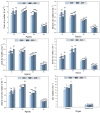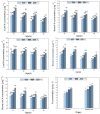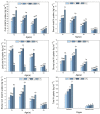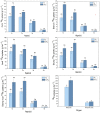Comparative study of urea-15N fate in pure bamboo and bamboo-broadleaf mixed forests
- PMID: 38835866
- PMCID: PMC11148377
- DOI: 10.3389/fpls.2024.1382934
Comparative study of urea-15N fate in pure bamboo and bamboo-broadleaf mixed forests
Abstract
Objectives: Bamboo is a globally significant plant with ecological, environmental, and economic bene-fits. Choosing suitable native tree species for mixed planting in bamboo forests is an effective measure for achieving both ecological and economic benefits of bamboo forests. However, little is currently known about the impact of bamboo forests on nitrogen cycling and utilization efficiency after mixing with other tree species. Therefore, our study aims to compare the nitrogen cycling in pure bamboo forests with that in mixed forests.
Methods: Through field experiments, we investigated pure Qiongzhuea tumidinoda forests and Q. tumidinoda-Phellodendron chinense mixed forests, and utilized 15N tracing technology to explore the fertilization effects and fate of urea-15N in different forest stands.
Results: The results demonstrated the following: 1) in both forest stands, bamboo culms account for the highest biomass percentage (42.99%-51.86%), while the leaves exhibited the highest nitrogen concentration and total nitrogen uptake (39.25%-44.52%/29.51%-33.21%, respectively) Additionally, the average nitrogen uptake rate of one-year-old bamboo is higher (0.25 mg kg-1 a-1) compared to other age groups. 2) the urea-15N absorption in mixed forests (1066.51-1141.61 g ha-1, including 949.65-1000.07 g ha-1 for bamboo and 116.86-141.54 g ha-1 for trees) was significantly higher than that in pure forests (663.93-727.62 g ha-1, P<0.05). Additionally, the 15N recovery efficiency of culms, branches, leaves, stumps, and stump roots in mixed forests was significantly higher than that in pure forests, with increases of 43.14%, 69.09%, 36.84%, 51.63%, 69.18%, 34.60%, and 26.89%, respectively. 3) the recovery efficiency of urea-15N in mixed forests (45.81%, comprising 40.43% for bamboo and 5.38% for trees) and the residual urea-15N recovery rate in the 0-60 cm soil layer (23.46%) are significantly higher compared to those in pure forests (28.61%/18.89%). This could be attributed to the nitrogen losses in mixed forests (30.73%, including losses from ammonia volatilization, runoff, leaching, and nitrification-denitrification) being significantly lower than those in pure forests (52.50%).
Conclusion: These findings suggest that compared to pure bamboo forests, bamboo in mixed forests exhibits higher nitrogen recovery efficiency, particularly with one-year-old bamboo playing a crucial role.
Keywords: 15N tracing technology; N recovery efficiency; Qiongzhuea tumidinoda; bamboo-broadleaf mixed forests; biomass.
Copyright © 2024 Wu, Dong, Zhong, Duan, Li, Pu, Li and Xie.
Conflict of interest statement
The authors declare that the research was conducted in the absence of any commercial or financial relationships that could be construed as a potential conflict of interest.
Figures












Similar articles
-
Linking enhanced soil nitrogen mineralization to increased fungal decomposition capacity with Moso bamboo invasion of broadleaf forests.Sci Total Environ. 2021 Jun 1;771:144779. doi: 10.1016/j.scitotenv.2020.144779. Epub 2021 Jan 25. Sci Total Environ. 2021. PMID: 33736125
-
Non-additive effects on biodegradation of moso bamboo litter- and broadleaf tree litter-leached dissolved organic matter mixtures in a subtropical forest of southern China.Sci Total Environ. 2024 Mar 10;915:170104. doi: 10.1016/j.scitotenv.2024.170104. Epub 2024 Jan 15. Sci Total Environ. 2024. PMID: 38232826
-
Soil bacterial community structure of mixed bamboo and broad-leaved forest based on tree crown width ratio.Sci Rep. 2020 Apr 16;10(1):6522. doi: 10.1038/s41598-020-63547-x. Sci Rep. 2020. PMID: 32300174 Free PMC article.
-
Soil biochemical responses to nitrogen addition in a bamboo forest.PLoS One. 2014 Jul 16;9(7):e102315. doi: 10.1371/journal.pone.0102315. eCollection 2014. PLoS One. 2014. PMID: 25029346 Free PMC article.
-
Seasonal linkages between soil nitrogen mineralization and the microbial community in broadleaf forests with Moso bamboo (Phyllostachys edulis) invasion.Sci Total Environ. 2023 Nov 15;899:165557. doi: 10.1016/j.scitotenv.2023.165557. Epub 2023 Jul 20. Sci Total Environ. 2023. PMID: 37478938
References
-
- Bai Y., Wei H., Ming A., Shu W., Shen W. (2023). Tree species mixing begets admixture of soil microbial communities: Variations along bulk soil, rhizosphere soil and root tissue. Geoderma 438, 116638. doi: 10.1016/j.geoderma.2023.116638 - DOI
-
- Bao S. D. (2000). Soil and agricultural chemistry analysis (Beijing: China Agriculture Press; ).
-
- Bauhus J., Forrester D. I., Gardiner B., Jactel H., Vallejo R., Pretzsch H. (2017). “Ecological stability of mixed-species forests,” in Mixed-Species Forests: Ecology and Management. Eds. Pretzsch H., Forrester D. I., Bauhus J. (Springer, Berlin, Heidelberg: ), 337–382. doi: 10.1007/978-3-662-54553-9_7 - DOI
-
- Cao K.-F. (2001). Morphology and growth of deciduous and evergreen broad-leaved saplings under different light conditions in a Chinese beech forest with dense bamboo undergrowth: Morphology and growth of saplings. Ecol. Res. 16, 509–517. doi: 10.1046/j.1440-1703.2001.00413.x - DOI
-
- Chalk P. M., Craswell E. T., Polidoro J. C., Chen D. (2015). Fate and efficiency of 15N-labelled slow-and controlled-release fertilizers. Nutr. Cycl Agroecosyst. 102, 167–178. doi: 10.1007/s10705-015-9697-2 - DOI
LinkOut - more resources
Full Text Sources
Research Materials

